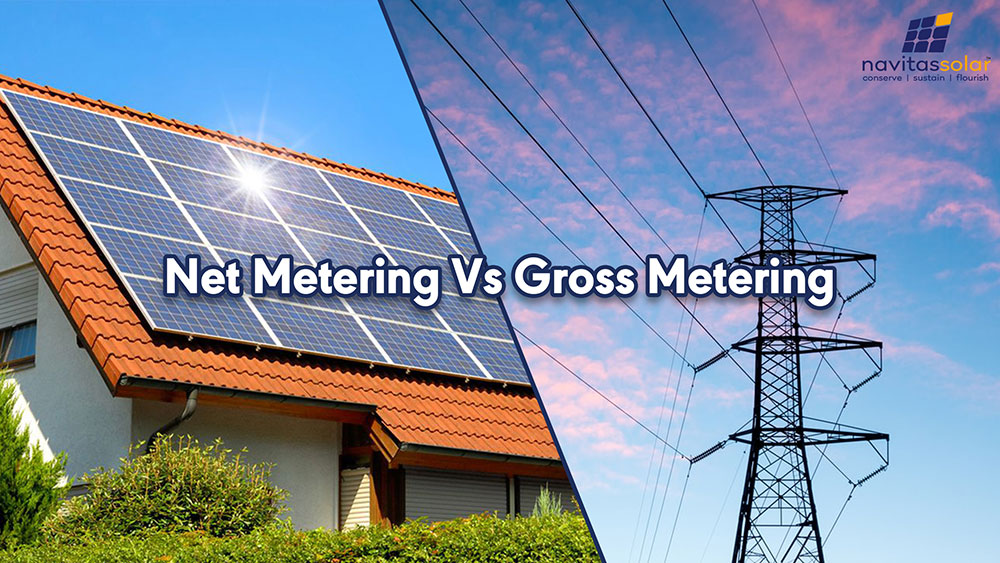March 25, 2022
Net Metering Vs Gross Metering
Net Metering Vs Gross Metering
- The biggest change occurred in generation of electricity in this era is Distributed Generation (DG)! The change that anyone would only imagine of is true these days. Yes, it is possible to generate our own electricity. The credit goes to Renewables for sure.
- Customers are able to install Rooftop Solar plants and generate their own electricity. India has solar insolation in abundant form so that rooftop solar has truly become a boon for users. Various policies launched by Government are useful for the end users to install solar rooftop.
- The basic issue in solar generation is that the generation is intermittent, so the end user might face problems in the nighttime if the solar rooftop is standalone type. The problem can be solved by installing solar rooftop with a battery that in daytime, user uses the solar generation and in the nighttime user uses the power from the battery. However, the rooftop solar with the battery becomes too costly.
- The problem can be solved by another method and that is grid connectivity. The solar rooftop is connected with the grid, so that the deficit power can be imported from the grid and the surplus power can be exported to the grid. Therefore, the end user will get the electricity continuously despite of having intermittent generation of solar. Majority of the solar rooftops are grid connected.
- There are two arrangements defined by governments to design solar rooftop: Net metering and Gross metering.
Net Metering
- In Net Metering, the electricity generated by solar rooftop plant is adjusted against the imports. Electricity produced by solar rooftop is deducted from the total energy consumption of the user over a period. The adjustments are based on different periods like monthly, bimonthly, half yearly or yearly based on the state government policies.
- Generally, a bidirectional net meter is connected which is able to measure the bidirectional energy like the electricity imported to the user from the grid and the electricity exported to the grid by the user.
- If the exported electricity is higher than the imported electricity, then the end user may or may not get compensation depending on the state’s net metering policy rules and regulations for supplying surplus electricity into the grid.
- In simple words, consumer may use the energy generated by soar rooftop plant and then may export the excess energy to the grid and in case of deficit, the consumer will use the energy imported from the grid.
Gross Metering
- In Gross Metering, two unidirectional gross meters are installed in the arrangement. One gross meter counts the energy being imported to the end user from the grid and the other gross meter counts the energy exported from consumer to the grid.
- The consumer is compensated at a fixed feed in tariff for the energy generated as well as exported to the grid and has to pay the retail supply tariff for the electricity imported from the grid.
- The feed in tariff and the retail supply tariff are generally of different rates. Mostly, feed in tariff is at lesser rate than retail supply rate.
- In simple words, consumer has to export all the energy generated by rooftop solar plant to the grid and then consume the electricity by importing the energy from the grid.


 Online | Privacy policy
Online | Privacy policy
Related Posts
You May Also Like
Bonito Series: Driving Innovation in…
Read MoreTOPCon Series: The Next Generation…
Read MoreValuable Points to Remember During…
Read MoreNavitas Planet Partners with Hysolwin…
Read MoreDriving Towards a Sustainable Future:…
Read MoreWhy Do Top-Grade EVA Sheets…
Read MoreBonito Series: Driving Innovation in…
Read MoreTOPCon Series: The Next Generation…
Read MoreValuable Points to Remember During…
Read MoreNavitas Planet Partners with Hysolwin…
Read MoreDriving Towards a Sustainable Future:…
Read MoreWhy Do Top-Grade EVA Sheets…
Read MoreBonito Series: Driving Innovation in…
Read MoreTOPCon Series: The Next Generation…
Read MoreValuable Points to Remember During…
Read MoreNavitas Planet Partners with Hysolwin…
Read More